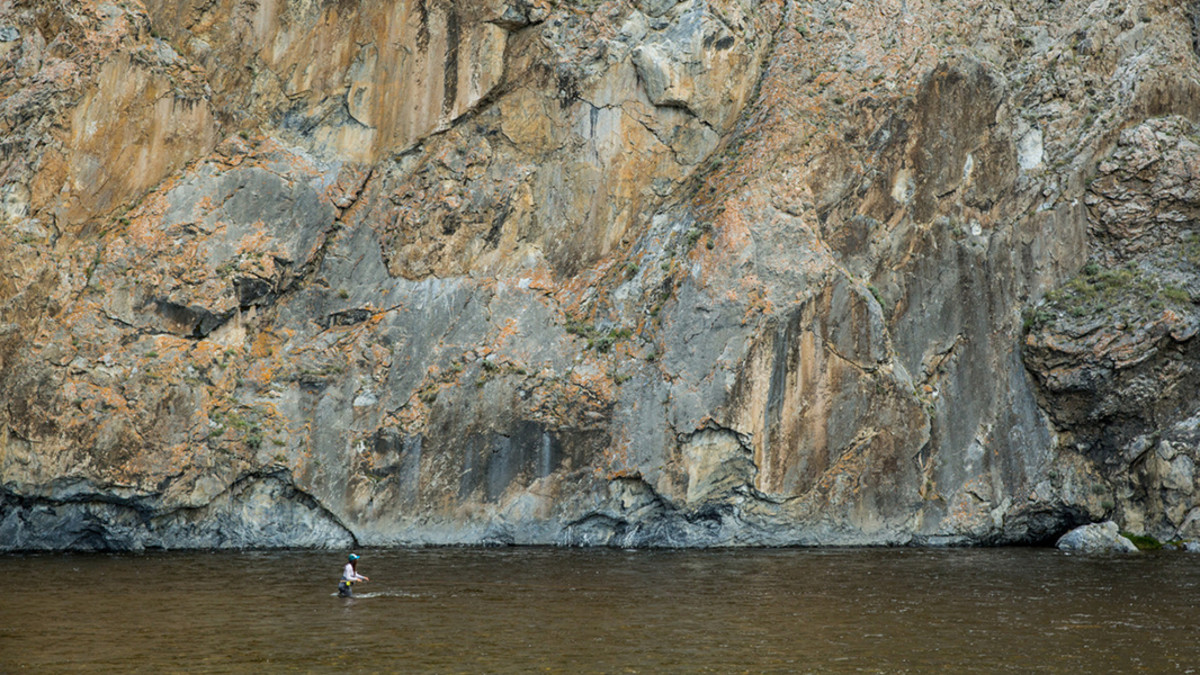
For the first few years of my guiding career, I fished for sturgeon and salmon out of a boat on the Fraser River. It wasn’t until I became a full-time steelhead guide that I realized just how many people are unsure of when, where, how, and why to step between casts.
When swinging flies (for any species), we start at the head of a run, stepping downstream between casts until reaching the tail-out. This means that the water is thoroughly covered and, hopefully, the fly is seen by any nearby fish.
But not everybody is familiar with this fishing method.
I used to have clients who’d stay in one spot all day if I didn’t stand next to them repeating “cast, swing, step….” In fact, I’m embarrassed to admit that I once had an 88-year-old man mistake my instruction to “just keep stepping down between casts” for “just keep stepping out….”
As I ran down to land his friend’s fish, I looked upstream to see him clinging to his walking stick with water pushing at his ribcage and threatening to wash him away. It was an eyeopener for us both. It was also one of the scariest moments of my life. He damn near dragged me into the current as I held his weight and navigated him back into shallow water.
Adding to the “when to step” confusion are the anglers who wade in the opposite direction. Lots of trout fishing, particularly nymphing, involves stepping in below the fish and casting upstream so that the fly can drift down into the fish’s feeding zone. In many trout rivers, standing in front of the fish means spooking it before a cast is even made.
The most common error I see are anglers fishing mechanically, moving without rhyme or reason, and taking steps for the sole purpose of covering water. While there are no rules when it comes to stepping between casts, there are some things to consider.
Water Clarity
How fast an angler moves through the run can depend greatly on water clarity. If the water is clear, more steps may be taken between each cast. I’ve seen steelhead swim almost ten feet to take a fly, and am therefore confident that fish see well in these conditions. In the case of clear water in a long, nondescript run, I may even take ten steps between casts. If a fish is interested in biting, it can be beneficial to present the fly to him sporadically so that he doesn’t bore or desensitize to it as it gradually gets closer to his face.
The logic is the same for dirty water. If visibility is limited, I’ll minimize my steps. Here, I may only take one step between casts — especially if I think a fish is there. Murky water can push fish closer to shore, so it’s never a bad idea to stand a little shallower than usual to allow the fly to swing in tight. I’ve caught fish in water so shallow, their fins stuck out as they chased the fly down.
Stepping and “Stripping” Simultaneously
This is the most common combination that I see. Once the angler’s fly is parallel to the shore (known as the ‘dangle’ in the Spey world), they take several steps downstream — stripping in line as they walk. In this case, the strip is not used to tempt the fish into biting, rather simply to retrieve line. To be fair, the retrieval is necessary to recast, but it could be done with a little more strategy.
This sort of mindless “stripping” while stepping is usually done for one of two reasons:
1). It’s the fastest way to move downstream and be ready to cast again.
2). It helps to keep the fly off the bottom so that it doesn’t snag. Walking downstream without stripping means the fly is left to drift down toward the clutching grasp of rocks and logs.
Personally, I try to leave my fly in the water for as long as possible. Fish are often attracted to the sharp, jolting movements of a fleeing baitfish, so I always finish my swing with a few short strips before stepping downstream—which brings me to my next point.
Stripping Before Stepping
I cannot count how many times I’ve seen a fish follow a fly the entire time it’s swinging. While standing atop a high bank, I’ve watched fish follow a client’s fly from the second it touched the water until it reached the dangle. Sometimes the fly has been swung too fast, or it may not look “quite right” to the fish. As the fly slows down and reaches the dangle, just as the fish is about to bite, the angler promptly pulls the fly away to recast. Luckily for the angler, they almost never realize that they’ve just lost a shot at a fish that was eager to eat their fly.
Five or ten quick, short strips may just be the perfect temptation for a curious fish. Before hastily stepping down and introducing slack into your line (making it impossible to feel if a fish has taken the fly), stay grounded and make a few strips before moving. If nothing bites, then continue to quickly pull the line in while stepping downstream.
Stepping Before Stripping
If the river-bottom is smooth or gravelly, it’s a good idea to step downstream after the fly has reached the dangle. Not only does this mean that the fly stays in the water longer, but it also changes its presentation so that it’s dead-drifting — which is often exactly what a fish is looking for. Be sure to step slowly enough so that the line doesn’t slacken, making it so that you can’t feel a bite.
It’s surprising just how many people fail to recognize the correlation between their body movements and line positioning. For every one person who deliberately leaves their fly in the water while they walk, there seem to be ten anglers who do it by mistake. Sometimes they are rewarded with an unexpectedly hooked fish, but usually, they just find themselves in a tug of war with a snag.
Stepping While Swinging
Depending on water height, speed, and structure, it’s often beneficial to slow the fly down enough to “keep it in the zone.” The “zone” can be any part of the river that looks like it holds fish. A change in the current that creates a seam, a trough where the water deepens, or a gathering of rocks that break up the water’s flow. There are various scenarios where the fly should be presented slow and broadside.
I do this by pointing the rod tip slightly upstream and then slowly stepping downstream while the fly swings. My pace is painfully slow, but it’s just fast enough to “hold” the fly in the zone. Stepping while swinging can be incredibly productive, but it’s important not to step too fast, or else slack is introduced into the line. Once the fly hits the dangle, be careful not to step downstream again, or else you may double-step, passing up unfished water.
It’s almost impossible to know what a fish is thinking, but something we do know for sure is that fish live in water. So the longer we can keep our hooks submerged, the more likely we are to get a bite. Try to be strategic when it’s time to move. We put so much focus on our casting and presentation — we should put just as much thought into the steps in between.



